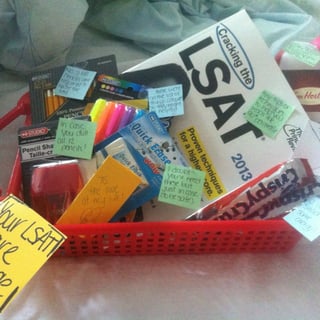The LSAT Analytical Reasoning, or Logic Games, can seem daunting if you walk in without a game plan. This week we will briefly discuss diagramming to give you a solid...
LSAT Analytical Reasoning: The Brainteasers Inherent in the System

Logic puzzles. You probably ran across them back in elementary or middle school—those weird brainteasers that asked you to do things like sort out which five kids lived in which five houses and liked which five fruits and that sort of thing. And you’d get clues—like “Alice lives next to the boy on Maple street”. Or “the girl who likes pears has never met anyone who prefers citrus fruits” (some great examples are in this video by The LSAT Trainer: https://www.youtube.com/watch?v=d7mUPexyLZE) Games like these have a way of generating enthusiasm or dismay, and while some people can happily spend hours on them, others tend to shred the paper in cognitively contorted frustration. So what on earth are such puzzles doing on a law exam? And how can you navigate your way through them?
Logic is, of course, fundamental to the study of law. Whether publicly arguing a complex case in a criminal court, or navigating arcane caselaw, you’ll need to understand clearly the logical premises, fallacies, strengths and weaknesses of the arguments and cases you’ll encounter. Law requires you to construct and deconstruct legal puzzles, place events in logical order, draw inferences and make associations. When you’re presented with a logic puzzle, you’re asked to demonstrate your ability to master the fundamentals of this kind of reasoning.
There are myriad puzzles such as these that you’ll encounter on the LSAT, but let’s take a look at solving one of them.
You have 6 obstacles to arrange in order in an obstacle course. These are a rope swing, a slide, a tunnel, a vault, a wall, and a zipline. The obstacles are arranged according to the following rules:
The slide must be in position 3 or 4
The wall is placed just before the zipline
The rope swing and vault cannot be placed right next to each other.
Which of the following are possible setups for the obstacle course?
- R T S W V Z
- T R V S W Z
- T R W Z S V
- V T S R W Z
- W Z S V R T
Puzzle modified from Powerscore
https://www.powerscore.com/lsat/logic-games/
This one is fairly straightforward, but it will get you a feel for how these puzzles work. To tackle them, you’ll want to lock down the easiest bits of information first. If you can find a rule that fixes something in place, you’ll make your life easier by eliminating possibilities for the more complicated clues.
The most basic clue here is the first one—S must be in position 3 or 4. Write it down to visualize:
_ _ S? S? _ _
Even though we can’t definitively place S in a position yet, we’ve narrowed the possibilities, and can definitely rule out any answer choice in which S doesn’t occur in position 3 or 4. So, for the above problem, we can rule out choice 3.
Next, work with the “W and Z” clue. The words “just before” indicate that the wall immediately precedes the zipline in our sequence of obstacles, as opposed to saying “before” which would give no information about the spacing between the two. Because they occur right next to each other, we can treat it as a W/Z block. And because we’ve narrowed down the location of “S”, there’s only a few options for the W/Z block: 4 to be precise. Let’s write them out:
WZS _ _ _ _ W Z S _ _ _ _ S W Z _ _ _ _ S W Z
Looking back at our answer choices, we can see that only choice 1. separates w and z, and we can therefore rule that one out.
Now for the most involved of the three—the non-consecutive V/R clue. It’s not particularly complicated, but if we had started there, we would have almost no information to restrict our starting point. But now that S is almost locked down, and we’ve narrowed down the possible locations for W/Z, there’s only so much that can be done with V/R, knowing that they CANNOT occur next to each other. But remember that V and R can switch – we know they cannot be next to each other, but we don’t know which comes first. So, going back to our remaining answer choices 2, 4, and 5, both 2 and 5 have V/R next to each other. Rule them out—our answer is Choice 4 (that’s it--you don’t even need to worry about T, the tunnel).
In the actual LSAT, this would only be the starting point in a sequence of related questions in which various parameters may be modified—perhaps T is given an initial location, or perhaps V and R must be separated by exactly two spaces. But once you’ve reduced the puzzle to spaces and symbols, the rest becomes much easier. Once you’ve mastered a few of these, it’s easy to see how the same kind of thinking and manipulation translates into real world applications, and hopefully by learning and applying some of these tactics, you’ll be able to make the arcane world of legal theory and practice that much more accessible!
About the Author
This article was written by Steve M., one of our most experienced test prep tutors in the Boston area. For more information on MyGuru's top LSAT tutors, click here.
